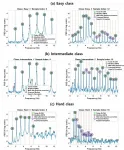(Press-News.org) Half of the Danish population have overweight, while 17 percent live with obesity. Worldwide, almost 40 procent have overweight and 13 procent live with obesity.
The condition is associated with increased risk for early death, as well as sequelae such as Type 2 diabetes, cardiovascular diseases, cancer, and infertility.
Weight regain after an initial successful weight loss in people with obesity, constitutes an important and unsolved problem. Until now, no well-documented study on which treatment method is best for maintaining a healthy weight loss has been available.
Researchers at University of Copenhagen and Hvidovre Hospital have completed a new, sensational study, which is being published in the world's most quoted medical journal, The New England Journal of Medicine. By testing four different types of treatment following a diet-induced weight loss, the researchers demonstrate for the first time how it is possible for people with obesity to maintain long-term weight loss, says Professor Signe Torekov at the Department of Biomedical Sciences.
In a randomized clinical trial, the group of researchers has demonstrated a highly effective treatment after a diet-induced weight loss, by combining moderate to vigorous-intensive exercise with appetite-inhibiting obesity medication, an analogue to the appetite-inhibiting hormone GLP-1.
"This is new knowledge for doctors, dietitians and physical therapists to use in practice. This is evidence that we have been missing," explains Signe Torekov, who has been heading the study.
"The problem is that people are fighting against strong biological forces when losing weight. The appetite increases simultaneously with decreased energy consumption, and this counteracts weight loss maintenance. We have an appetite-stimulating hormone, which increases dramatically when we lose weight, and simultaneously the level of appetite-suppressing hormones drops dramatically. In addition, a weight loss can provoke loss of muscle mass, while the body reduces the energy consumption. Thus, when the focus in obesity treatment has been on how to obtain a weight loss - rather than how to maintain a weight loss - it is really difficult to do something about your situation," says Signe Torekov.
Highly efficient when combining treatments
215 Danes with obesity and low fitness ratings participated in the study. The participants initially followed a low calorie diet over eight weeks, where they each lost approximately 13 kg, which brought significant improvements to their health with a drop in blood sugar level and blood pressure.
The participants were then randomly divided into four groups. Two of the groups received placebo medication, while the two other groups received obesity medication. Among the two placebo groups, one group followed an exercise program of minimum 150 minutes of physical activity at moderate intensity or 75 minutes at vigorous-intensity during the week or a combination of the two, while the other group maintained their current level of physical activity. The two groups receiving obesity medication were similarly divided into one group with and one group without an exercise program.
All participants in the study were weighed monthly and received nutritional and diet counseling with the focus on healthy weight loss according to the guidelines from the Danish health and food administrations.
After one year, the group with exercise alone and the group with obesity medication alone maintained the weight loss of 13 kg and health improvements. The placebo group gained half of the weight back with deterioration of all risk factors, for example for development of Type 2 diabetes and cardiovascular disease.
The most dramatic improvements occurred in the combination group, which followed the exercise program and received obesity medication. The researchers observed additional weight loss in this group, and the total weight loss was approximately 16 kg over one year. The health benefits were also double that of each of the single treatments, i.e., twice the loss of fat mass while preserving muscle mass, higher fitness ratings, reduced blood sugar and improved quality of life.
The two groups that exercised increased their fitness rating, lost fat mass, and gained muscle mass. This could indicate a healthier weight loss than for people, who had only lost fat mass without increasing the fitness rating.
"It is an important aspect to highlight, as you do not necessarily get a healthier body from losing weight if, at the same time, you lose a lot of muscle mass," says Signe Torekov.
"It is great news for public health that a significant weight loss can be maintained with exercise for approximately 115 minute per week performed mostly at vigorous-intensity, such as cycling. And that by combining exercise with obesity medication, the effect is twice as good as each of the individual treatments"."
With the study, the researchers now hope people with obesity, together with their care provider, can create a useful framework for maintaining the weight loss.
Fundamental lifestyle change
Signe Torekov points out that many people with obesity have tried to lose weight before, only to regain the weight. This happens, because the general advice is to eat healthier and exercise more.
"Without a follow-up on whether people actually have support to perform exercise, the treatment will not be enough. Therefore, we also followed up with the participants on an ongoing basis to ensure that they received the support they needed in order to exercise. That is necessary, because maintaining weight loss is extremely hard. People need to understand this. Once you have lost weight, you are not "cured". "The ongoing exercise and effort will likely need to continue for many years," says Signe Torekov.
"Our study also demonstrates that without a structured treatment plan, there is a high risk of gaining the weight back. There were 12 individual consultations over the course of a year, including weighing and diet advice from Danish authorities according to guidelines for healthy weight maintenance. This was just not enough for the placebo group without exercise program, in this group all health benefits gained by weight loss during the eight week program were gone after one year, despite frequent weighing and diet and nutritional counseling based on official guidelines". Torekov says.
According to Signe Torekov, this underscores the importance of participating in a mutual weight maintenance program based on feedback when starting a weight loss programme.
"Therefore, it is important that there is a system for supporting people with obesity in maintaining the lifestyle change. Our study can help with this, because we can say this actually works to doctors, dietitians and municipalities, if they create a structured, joint treatment plan with the individual using ongoing follow-ups," says Torekov.
INFORMATION:
Oxygen is essential for the development of higher life. However, it was hardly present in the oceans of the young Earth. It was not until the evolution of photosynthetic bacteria that the oceans saw a significant increase in oxygen levels. By measuring tungsten isotope composition, an international research team with the participation of scientists from the University of Cologne's Institute of Geology and Mineralogy has now laid the foundation for a more precise determination of the development of oxygen levels in the early oceans over time. Prospectively, they expect more precise insights into the evolution of life. In cooperation with scientists from ETH Zurich, the Universities of Bern and Tübingen, and the Leibniz Institute for Baltic Sea Research ...
Research conducted by the University of Birmingham shows in order to have an effective Covid-19 vaccination rollout it has to be widely accepted by the entire population.
The study, conducted in collaboration with the NIHR Clinical Research Network West Midlands and The Royal Wolverhampton NHS Trust was published in the journal Trials involved an anonymous cross-sectional online survey across the UK involving 4884 participants of which 9.44% were Black Asian Minority Ethnic (BAME). Overall, 2020 (41.4%) respondents were interested in participating in vaccine trials, while 27.6% of the respondents were not interested and 31.1% were unsure. The most interested groups were male, graduates the 40-49 and 50-59 age groups ...
a Photocatalytic biomass conversion is an ideal way of generating syngas (H2 and CO) via C-C bond cleavage, which is initiated by hydrogen abstraction of O/C-H bond. However, the lack of efficient electron-proton transfer limits its efficiency. Conversional gasification of biomass into syngas needs to be operated at high temperature (400-700 °C).
Recently, a group led by Prof. WANG Feng from the Dalian Institute of Chemical Physics (DICP) of the Chinese Academy of Sciences (CAS), in collaboration with Prof. WANG Min from Dalian University of Technology, proposed a new method to realize photocatalytic conversion of biopolyols to syngas at room temperature with high efficiency.
This study was published in Journal of the American Chemical ...
The Korea Institute of Civil Engineering and Building Technology (KICT) has announced the development of a fully-automated peak-picking method for cable monitoring. The developed method will improve reliability of the method. Such as Incheon Bridge in South Korea, Cable-stayed bridges have received significant attention as efficient structural systems worldwide. In this regard, newly developed cable monitoring systems have become an essential and efficient maintenance approach for cable-stayed bridges. As structural integrity for stay-cables, tension force and damping ratio have been widely utilized as efficient metrics.
A research team in KICT, led by Dr. Seung-Seop Jin, has developed a fully-automated peak-picking ...
Moderate alcohol intake--defined as no more than one alcoholic drink for women and two for men per day--has been associated with a lower risk of dying from cardiovascular disease when compared with individuals who abstain from drinking or partake in excessive drinking, according to a new study being presented at the American College of Cardiology's 70th Annual Scientific Session. It's also the first study to show that drinking moderate amounts of alcohol may be heart protective, in part, by reducing stress-related brain signals based on a subset of patients who underwent brain imaging.
"We found that stress-related activity in the brain was higher in non-drinkers ...
Nearly 1 in 5 adults with high blood pressure, a leading risk factor for heart disease and stroke, also take a medicine that could be elevating their blood pressure, according to new research presented at the American College of Cardiology's 70th Annual Scientific Session. The results underscore the need for patients to routinely review all of the medications they take with their care team, including those available over the counter, to make sure none could be interfering with blood pressure lowering efforts.
Which are the most likely culprits? Based on the study findings, the three most common classes of medications were antidepressants; nonsteroidal anti-inflammatory drugs (NSAIDs) that include ibuprofen and naproxen; and oral ...
Among younger adults visiting the emergency department for chest pain, women may be getting the short end of the stick. Compared with men of similar age, women were triaged less urgently, waited longer to be seen, and were less likely to undergo basic tests or be hospitalized or admitted for observation to diagnose a heart attack, according to new research being presented at the American College of Cardiology's 70th Annual Scientific Session.
The study is the first to examine emergency room management of chest pain specifically among younger adults (age 18-55 years). Heart disease is the leading cause of death in women and is becoming more common in younger adults. About one-third of women who were hospitalized ...
Young and middle-aged adults who reported severe psychological distress--such as depression or anxiety--after suffering a heart attack were more than twice as likely to suffer a second cardiac event within five years compared with those experiencing only mild distress, according to a study presented at the American College of Cardiology's 70th Annual Scientific Session.
The study is the first to comprehensively assess how mental health influences the outlook for younger heart attack survivors, according to the researchers. The researchers also tracked ...
Social factors such as education, financial stability, food security and the neighborhood where someone resides were strongly correlated with whether or not individuals with heart disease adopted measures to prevent the spread of COVID-19, including wearing masks and working from home, according to a study presented at the American College of Cardiology's 70th Annual Scientific Session. The researchers say the findings draw attention to longstanding challenges related to social determinants of health.
"Unless we look at COVID-19 through the lens of social determinants of health, we may not optimize our yield from interventions, and we might not be reaching ...
Middle Triassic ichthyosaurs are rare, and mostly small in size. The new Besanosaurus specimens described in the peer-reviewed journal PeerJ - the Journal of Life and Environmental Sciences - by Italian, Swiss, Dutch and Polish paleontologists provide new information on the anatomy of this fish-like ancient reptile, revealing its diet and exceptionally large adult size: up to 8 meters, a real record among all marine predators of this geological epoch. In fact, Besanosaurus is the earliest large-sized marine diapsid - the group to which lizards, snakes, crocodiles, and their extinct cousins belong to - with a long and narrow snout.
Besanosaurus leptorhynchus was originally discovered near Besano (Italy) three decades ago, during systematic excavations led by the Natural ...




